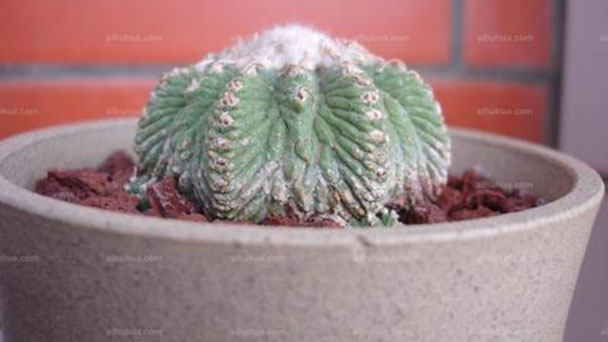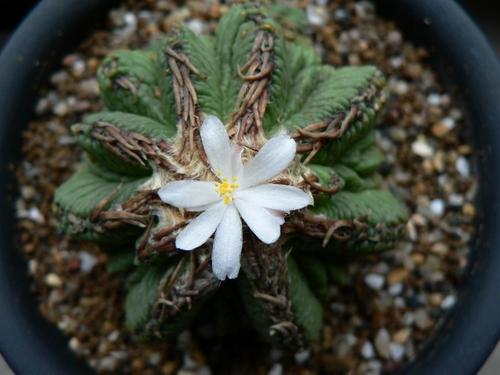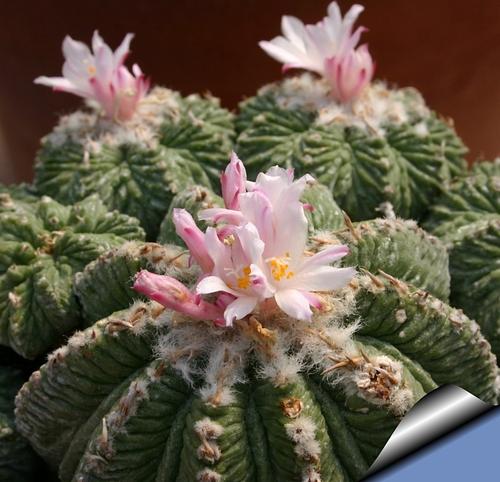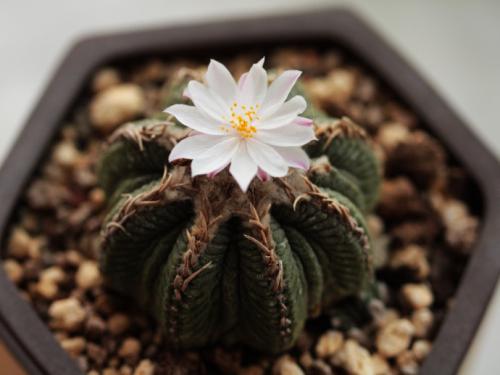Aztekium Ritteri profile
Written by Maggie
Oct 15 2021

Aztekium Ritteri is a succulent plant of the genus Aztekium in the Cactaceae family, located in a small valley (Rayones Valley) of Nuevo Leon in northeastern Mexico.
Aztekium Ritteri Picture

Aztekium Ritteri Characteristics
Aztekium Ritteri Root
Aztekium Ritteri has a very special appearance and is not usually confused with other balls. The individual of the aztekium Ritteri is small, the diameter of the single head is generally 3~5cm, the largest is generally 7cm, oblate globose. In line with the environment in which aztekium ritteri grows, it lacks the well-developed, water-storing fleshy roots of common cactus plants.
Younger plants of Aztekium Ritteri are pale grass green in color, while older plants tend to be grayish green. Under artificial cultivation conditions, the young parts of Aztekium Ritteri show a purplish red color, which is more pronounced on grafted plants.
Aztekium Ritteri Ball
The sphere of Aztekium Ritteri usually has about 6 to 12 edges, and in between the edges, there are many small secondary edges, as if the whole edge is wrinkled, which is also the origin of the Chinese name of the genus: Ritterum.
Aztekium Ritteri spheres were covered with 1 to 3 earthen yellow spines and tiny villi, which grew along the centerline of the ridges and the parasite ridges without villi.
Aztekium Ritteri Flowers
The flowers of Aztekium Ritteri are small, not more than 1cm in diameter. They are white and pinkish with darker outer petals. The flowers of Aztekium Ritteri grafted on Aztekium Ritteri are usually more reddish in color and the petals are often fringed with darker edges. Flowers emerge from villi at the top of the bulb, with six calyx petals open at the same time. The flowers have long, goblet - shaped tubes, slightly scented flowers and tiny seeds. The seeds of wild Aztekium Ritteri are usually spread by wind.
Aztekium Ritteri usually blooms from spring to autumn, but mainly around the turn of spring and summer.
Aztekium Ritteri Native Habits
Aztekium Ritteri likes to grow on steep cliffs composed mainly of brittle limestone. It often grows on the shady side of shaded slope rocks and roots on mosses. Aztekium Ritteri is gregarious and grows in groups where its native land has not been disturbed.
Aztekium Ritteri Care
Aztekium Ritteri Root Care
Generally speaking, few wild individuals can prune roots, right? The roots are clean. General living individuals, with a large number of fibrous roots, are more common, this time need to trim the root? It turned out that my opinion had always been that Aztekium Ritteri did not require root trimming. But after the last two years of growing Aztekium Ritteri, it seems that the large horticultural Aztekium Ritteri still needs to be cleaned of the fibrous roots, especially the big ones. I trimmed two roots of Aztekium Ritteri last year and they turned out to be very strong roots with the original soil, a big lump and a sphere in size. With an experimental attitude, I began to prune the roots. The old fibrous roots were pruned away. After the removal and pruning of the old soil, I found that the taproots under the original Aztekium Ritteri were very weak. Therefore, it is recommended to prune the roots of Aztekium Ritteri, especially when it comes in, which is conducive to the recovery of the sphere growth.
Given the aforementioned special skin structure of Aztekium Ritteri, the roots of the hair suggest two things to hold on to: humidity and temperature. After enough time to cool the roots, dry soil on the basin and wait for a few days after the weather temperature in 20-25 degrees around the spray ball wet, so 2-3 times after watering.As long as the temperature is stable, the ventilation is good, and you have enough air and humidity, the root speed is actually OK.
Aztekium Ritteri Soil Requirements
Family farming to play with not, with the soil recommended pure particles, that is to say, the powder in the soil must be sifted clean, the ratio does not matter but should pay attention to two points: with the soil to have the composition of limestone particles (generally can choose limestone small particles or volcanic rock particles), particles to a little smaller, mung bean size is more appropriate. Aztekium Ritteri requires a lot of soil permeability, so if you use yellow mud you should also recommend a sustained period of drying, which is very helpful for the root system.
Aztekium Ritteri Watering
In general, Aztekium Ritteri is very easy to grow, almost equivalent to grass balls. In the whole dormant period can be completely ignored, as long as not frozen from cold wind completely cut off water, can tolerate minus 5 degrees or even lower temperature. During the semi-dormant period of high temperature in midsummer, the water can be properly controlled and the ball can be sprayed and ventilated at night (this applies to the hair root period). Aztekium Ritteri grows vigorously during the period from the stable temperature in spring to the cooling in early winter when the semi-dormancy is removed. Water can be used every 2-3 weeks or so. During this period, it is OK to control obvious dry and wet conditions. It is also recommended to give the orb a thorough bath before watering it. The flowering of Aztekium Ritteri occurs in early summer and early autumn, with the most intense flowering occurring in early summer.

Aztekium Ritteri Lighting
Treat differently. Adultants of old Aztekium Ritteri, especially wild social individuals, are relatively tolerant to sunlight and can see full light from winter to late spring. As long as the light is not too sudden and changes obviously, it is very suitable for old Aztekium Ritteri. In summer, one or two layers of shading nets are generally selected until late autumn. In addition to winter, the plants and individuals generally need shade, otherwise it is easy to sunburn. Aztekium Ritteri, relatively light resistant, in principle to adapt to strong light service, to grow well needs more sun exposure.
Aztekium Ritteri Ventilation
My basic point about Aztekium Ritteri farming is that it requires ventilation, which is very important but I don't need to say much more.
Aztekium Ritteri Fertilizer
In principle, fertilization is a difficult thing to control, especially the old Aztekium Ritteri, which is prone to small heads, should be used less.
The skin structure of Aztekium Ritteri can absorb water, whether it is rain or moisture in the air, which is a feature that we need to pay attention to and take advantage of in the process of farming. Watering or spraying or are the need to pay attention to this point, when you do not know whether to water when the choice to spray the ball.
Aztekium Ritteri Propagation
Aztekium Ritteri Seed propagation
Aztekium Ritteri typically take seed breeding, but this is a very difficult thing, because although Aztekium Ritteri seed is very easy to get, germination rate is also high, but the management of the seedling difficulty is very big, a note can not be dried ripe, don't go to see a few days is likely to be swallowed up by a mossy think long molding need too much concern and care, so the health cultivation Aztekium Ritteri is a requires great patience and can only be achieved after a very long time.
Aztekium Ritteri Grafting propagation
Aztekium Ritteri can be propagated by grafting, usually by side bud grafting, seedling grafting is almost impossible. The grafted Aztekium Ritteri usually produces no balls, especially when grafted on the tricorn, and it does not take many years for the grafted balls to grow to 10cm. The triangular grafting plant is suitable for harvesting seeds, but it is not good to see because it is very fond of producing seeds, and the cold and heat resistance, life and beauty of the triangular grafting plant are also not ideal. Recommend south and north friends to use Longshen column grafting, the operation is simple, the survival rate is higher.
Due to the poor cold resistance of the Aztekium Ritteri in winter in the Yangtze River Basin, Xiupu column grafting is recommended. However, Xiupu grafting is difficult, because Aztekium Ritteri's vascular bundle is very small, its sphere is hard, and it is also short of water. Usually, small scions can only be selected to graft on the tips of the young Aztekium Ritteri to improve the survival rate. The grafted Aztekium Ritteri can hardly produce roots on the ground, and the lateral buds of the grafted Aztekium Ritteri can hardly propagate roots from cuttings, especially the plants grafted on the triangle, which usually shrink or rot before they have roots.
Aztekium Ritteri Cutting propagation
In addition to the fruit, wild lateral buds of 3~4cm were used for cutting propagation in Japan. But once the roots have been found, the cultivation of Aztekium Ritteri is not so difficult.
Aztekium Ritteri Disease Control
Sprays 2 to 3 times in spring, summer and fall with fungicides (metazol, carbendazim, etc.). Beware of scale insects and root powder. Red spiders and aphids are less likely to harm hard and less succulent pellets such as Aztekium Ritteri. We can join in the cultivation soil insecticide, pay more attention to prevention.

Latest Updated
- Benefits of Bugleweed - 7 Science-backed Health Benefits
- Bugleweed Dangers & Side Effects - Is It Poisonous?
- How to Plant Evergreen Trees - What You Should Know
- When to Plant Evergreens - Grow Guide for Evergreen Trees
- 12 Wonderful Evergreen Shrubs for Your Garden
- 12 Popular Evergreen Plants with Pictures for Beginners
- When And How To Prune A Lilac Bush Like a Pro
- How to Grow & Care for Lilac Vine (Hardenbergia Violacea)
- Japanese Lilac Tree (Syringa Reticulata) Care & Propagation Guide
- Shumard Oak Pros and Cons - What to Know
Popular Articles
- Winter maintenance of Antirrhinum Majus
- How to Grow Terminalia Mantaly Tree
- How to Grow and Care for Crossostephium Chinense
- How to grow Antirrhinum Majus in spring
- Peristeria Elata (Dove Orchid) Profile: Info & Care Guide
- Underwatered Snake Plant (Sansevieria Trifasciata) - Signs And How To Fix
- How to Care for Brazilian Jasmine Plant (Mandevilla Sanderi)
- How to Grow & Care for Graptopetalum Purple Delight in Summer
- Rosa Chinensis (China Rose): Plant Growing & Care Tips
- How to Care for Baby Sun Rose (Aptenia Cordifolia)